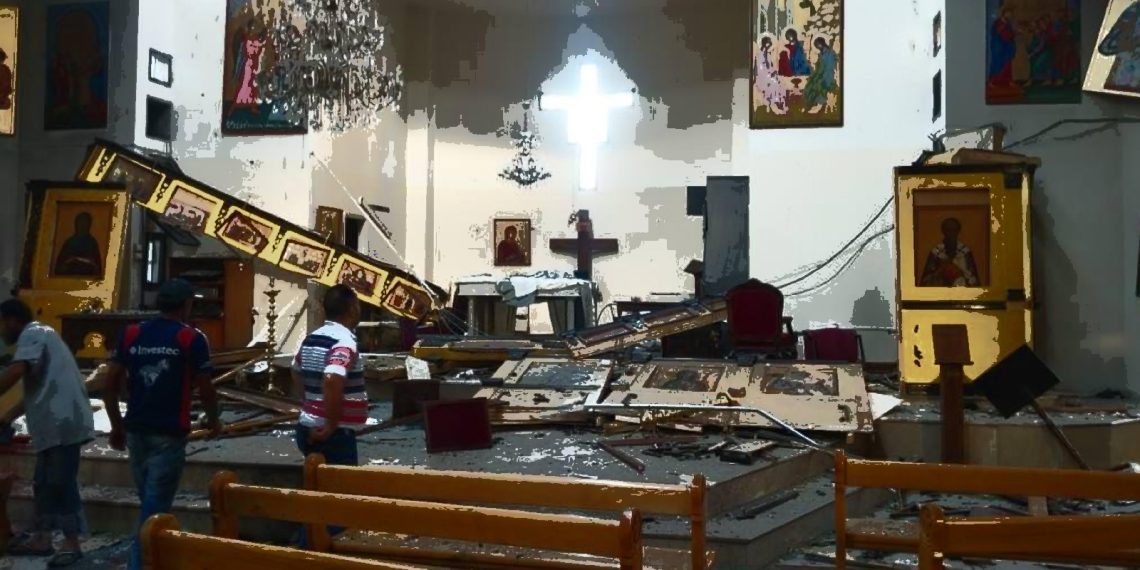Questions are mounting over the fragility of Syria’s security, the duplicity in the treatment of victims, and the deepening divide between minorities and a government that purports to represent all citizens. These developments mark a further erosion of the last remnants of trust in the nascent Syrian state project.
What many feared—yet long believed improbable—has come to pass: a bombing in a church near Damascus has claimed the lives of more than twenty worshippers and left dozens injured. Few losses are as searing as the sudden death of a loved one, and the pain from this tragedy has settled heavily in the collective Syrian heart. Yet beyond the physical and emotional toll lies a deeper, more insidious wound—a gash in the soul of the nation.
For years, Syrians clung to the fragile belief that their country was immune to such atrocities. Incidents of sectarian violence were horrors that happened in Iraq, Egypt, or Pakistan—but not in Syria, and certainly not in Damascus. That illusion has now been shattered. And as if the bombing itself were not horrific enough, the government’s response only reinforced a bitter truth: there is no one left to console the bereaved, comfort the wounded, or uphold justice.
The state’s initial response came as a statement condemning “in the strongest terms the terrorist attack targeting Mar Elias Church in the Douwaila neighbourhood of Damascus”—as if Douwaila were in Greece, or Damascus the capital of Yemen. But a government’s duty is not merely to condemn. It must acknowledge tragedy, classify the crime, promise accountability, and commit to preventing its recurrence. A fitting contrast lies in Angela Merkel’s response to the 2016 terrorist attack on Berlin’s Breitscheidplatz Christmas market: the German chancellor publicly expressed her deep shock and sorrow and reaffirmed Germany’s commitment to the rule of law and an open, free society.
Hours after the church bombing, Syrian authorities announced that they had uncovered the network behind the attack and attributed responsibility to the so-called Islamic State. Yet a previously unknown group, Saraya Ansar al-Sunna, stepped forward to claim the operation. The group identified the suicide bomber and denied any connection to ISIS, instead attributing him to an extremist splinter faction of Hay’at Tahrir al-Sham, known for targeting minorities. The same group had claimed responsibility for massacres in Syria’s coastal countryside earlier this year. Despite the gravity of these revelations, the authorities had issued no prior warnings about this group or its activities—raising serious public concern over the opacity surrounding its emergence and the silence around the investigation’s findings.
The bombing—and the government’s tepid response—not only exposed the growing threat of sectarian terrorism but also revealed the extent of Syria’s internal fracture. Among Syrian Christians, the prevailing emotions were fear and betrayal—a loss of trust not only in the state but in society itself, and in the very idea of a shared future.
The impact was especially acute given the sacredness of the attack’s setting. For many, the tragedy revealed a profound failure by the post-conflict authorities to provide even the most basic protection. Government statements announcing the arrest of a linked terror cell did little to quell the outrage. The refusal to describe the victims as “martyrs” was widely seen as emblematic of a lingering religious bias within the institutions of state.
The bombing has only sharpened already acute anxieties about Syria’s deteriorating security, the unequal treatment of its citizens, and the widening gulf between minorities and a regime that claims to govern in their name. All signs point to a dangerous erosion of whatever residual confidence remains in the Syrian state’s reconstruction.
But this descent did not begin yesterday.
From Roses to Dynamite
Over the past fifteen years, Syria has descended into an abyss of violence and hatred unprecedented in its modern history. Hate speech and sectarian incitement—especially via social media—have become the sparks that ignite new rounds of violence, steadily eroding the country’s social fabric and crushing aspirations for coexistence.
Some spread this rhetoric for amusement, seemingly oblivious—or indifferent—to the dangerous consequences of stoking cycles of hatred and violence. What began as a symbolic reflection of Syria’s vertical fractures—across sects, tribes, doctrines, and regions—has now become a weaponised form of psychological warfare, used to dehumanise entire communities and legitimise their targeting.
This climate of hatred has only intensified in the absence of legal safeguards and oversight, particularly over non-state actors. These failures obstruct national recovery and place what little remains of Syria’s social cohesion in grave jeopardy.
The Assad regime bears primary responsibility for this descent, having committed heinous crimes against humanity—extrajudicial killings, ethnic cleansing, torture, starvation, and the systematic destruction of homes, hospitals, schools, bakeries, and places of worship. After the regime’s collapse and the flight of its leader, fears of a wave of sectarian retribution loomed large—threatening to plunge Syria into an even darker abyss. Though that nightmare scenario did not fully materialise, violence continues to claim the lives of innocent civilians, while many of the regime’s worst offenders remain protected by the new authorities.
A generation of Syrians has now come of age knowing nothing but war, division, and despair. For some, this fractured reality has come to feel normal—perhaps even preferable to the unknown. This article is a challenge to that fatalism—a reminder that Syria’s revolution began peacefully, with hope, before being hijacked and weaponised by geopolitical schemers and profiteers of blood.
Here, we trace the moment the light began to fade—when hope turned to despair, and the candles were extinguished in the church.


